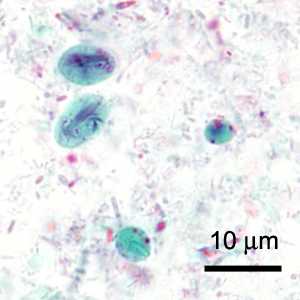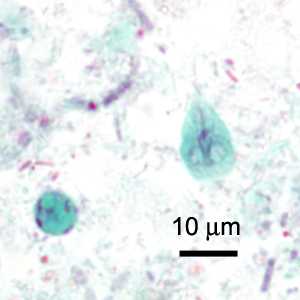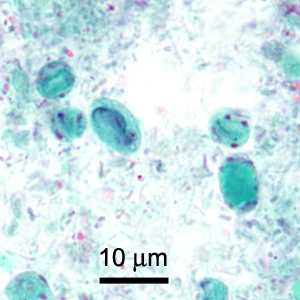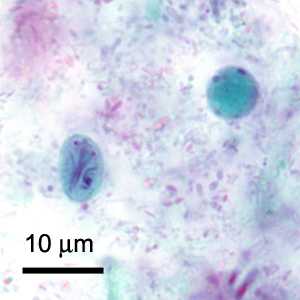
Case #419 - May 2016
A 23-year-old female presented to her primary care provider with abdominal pain, cramps, flatulence, and diarrhea five days after returning from a white water rafting trip in the Grand Canyon, Arizona. Stool specimens were collected in 10% formalin and zinc polyvinyl alcohol (Zn-PVA) and sent to a reference lab for routine ova-and-parasite (O&P) testing. Figures A-D show what was observed on a trichrome-stain slide of stool preserved in the Zn-PVA. Images were captured at 1000x magnification with oil. What is your diagnosis? Based on what criteria?

Figure A

Figure B

Figure C

Figure D
Case Answer
- ellipsoidal cysts of within the size-range (8-19 μm) for G. duodenalis (Figures A, C, D) that contained multiple nuclei, fibrils, and axonemes.
- pyriform trophozoite within the size range (10-20 μm) for G. duodenalis (Figure B) that contained fibrils,median bodies, two nuclei, and sucking disks.
- cyst-like forms of B. hominis (Figures A-D) containing a large central body surrounded by a narrow rim of cytoplasm containing nuclei and inclusion bodies.
More on: Giardiasis, Blastocystis hominis infection
DPDx is an education resource designed for health professionals and laboratory scientists. For an overview including prevention and control visit www.cdc.gov/parasites/.
- Page last reviewed: August 24, 2016
- Page last updated: August 24, 2016
- Content source:
- Global Health – Division of Parasitic Diseases and Malaria
- Notice: Linking to a non-federal site does not constitute an endorsement by HHS, CDC or any of its employees of the sponsors or the information and products presented on the site.
- Maintained By:


 ShareCompartir
ShareCompartir